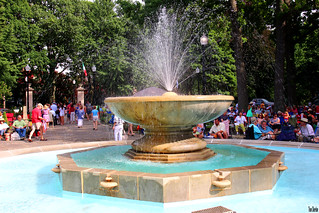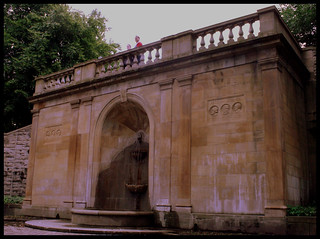General notes on Image 4
- This is the image for March (or possibly December) and the immigration reference is to Greece.
- This image was the match for Verse 4 and the casque that was found in Cleveland, OH in 2004. Veni, vidi, vici.
- The proposed solution for this casque is given on the Image 4 Verse 4 Solution page.

Specific Observations
Please record your notes about this image in the list below. Use the letter/number grid to identify the point on the image that you're describing. To keep things organized, 1) please start each observation with a letter/number combo (in bold), and 2) add new observations in the right place on the list to keep everything alphabetized.
- A1-D2 - The outline of Cleveland's Terminal Tower is upside-down in the trees.
- G3 - The triangle inside a sphere could be a reference to Euclid, the "Father of Geometry," and to Euclid Avenue, which passes by the southern tip of Rockefeller Park.
- H5 - The jewel is an aquamarine, the birthstone for March.
- I3 - The date (or number) 1442. See "Latitude / Longitude Hints" below.
- I8 - The date (or number) 1881. See "Latitude / Longitude Hints" below.
- O5 - The traditional birth flower for March is a daffodil, also known as a narcissus. However, some believe there may have been a mixup. (More info below).
Other Notes:
- Brian Zinn found the casque for this image in the Greek Cultural Garden in Cleveland in 2004. You can read more about his discovery in the article from the Plain Dealer Sunday Magazine (6/13/04).
- The painting shows a centaur, which fits with the Greek theme of this casque.
- The image for the centaur may also be another hint at Cleveland. NASA's upper stage Centaur Rocket was developed at the Lewis Research Center (now the John H. Glenn Research Center) in Cleveland. Active from the 60's - 80's this upper stage rocket helped launch the pre-Moon landing Surveyor probes, both Voyagers 1 & 2, various Shuttle payloads and many others.
Image Matches
|
Every image in The Secret includes some representation of a number, to indicate the corresponding month of the year. The three points (or sides) of the triangle on the sphere are thought to represent March (the third month of the year). That corresponds to the aquamarine, the birthstone for March. |
 |
|
| Nearly every image of The Secret also includes either the signature or initials of the artist John Jude Palencar. No obvious initials are to be found in this image. It is possible that the imperfections and shadows on the wall at approximately H8 (above the 1881 icon) are a representation of his initials. | ||
| The tree branches (or roots) to the left of the monument form the approximate outline of Ohio. The lines in the interior seem to be an equally abstract representation of the state's major highways. |
 |
 |
|
There is a wedge-shaped gap between the trees in the upper-left corner. Rotated 180 degrees (as shown here), it forms the profile of Cleveland's Terminal Tower. |
 |
 |
| The chalice held by the centaur is based on the shape of the fountain in the Italian Cultural Garden, which is next to the Greek Cultural Garden. |
 |
 |
| The stone arch and the recessed fountain are both taken very directly from the stonework in the Italian Cultural Garden. |
 |
|
|
In the magazine article describing the find, John Jude Palencar, the artist for the book, is quoted as saying "There was something to do with the helmet the centaur wears, but I can't remember what. My God, it's 22 years later."
Though a centaur is Greek in origin, the face on the centaur icon may resemble the face of a statue that is in the Italian Cultural Garden. If that is the case, the wreath and hair treatment on the statue may be the inspiration for the centaur's helmet. |
||
| It may be possible that Byron was inspired by yet another Renaissance Painter: El Greco (Although he gained his fame in Spain, he was actually a Greek Citizen, hence the Spanish nickname ‘The Greek’). His name also happens to be etched into the wall at the Greek Gardens along with Socrates and Pindar. Therefore, it may not be Apelles that Byron Preiss was referring to. In fact, El Greco's painting of "Saint Martin & the Beggar" looks very similar to the Centaur. |  |
 |
| The stone columns on the sides of the monument are similar to the stone columns flanking the arch in the Italian Cultural Garden, but they also resemble the columns at the entrance to the Greek Cultural Garden at 1000 East Boulevard. Someone facing the columns would be able to look between them and see the distinctive wall at the end of the garden. |
 |
 |
 |
 |
|
|
Some people have suggested that the bell in this symbol represents Bellflower Road which, like Euclid Avenue, is at the southern tip of Rockefeller Park.
If this icon is in some way representative of Bellflower Road, it should also be noted that its placement is right below the flower. These icons in close proximity may or may not indicate they are to be related. However since the reading of lines of text generally flows down rather than up, one would have to reverse that in order to read Bell+Flower from this grouping. |
 |
|
|
The birth flower for March is the Daffodil. Also known as a Narcissus - so named for the Greek myth.
There are many types and varieties of the Narcissus, featuring different numbers petals of different shapes as well as different coronas (flower center).
The flower pictured in the image resembles some types of daffodils more than it does others. Two of the varieties that it resembles the most are pictured at right.
With the Narcissus name being derived from the Greek myth tying in nicely with the Greek immigration theme, the Poet's Daffodil may be a connection to the mention of the Greek poet Pindar in verse 4. Or the Narcissus Italicus may be another connection to the thinking that the Italian Cultural gardens factors heavily into this puzzle. |
Narcissus Poeticus |
Narcissus Italicus |
Latitude / Longitude Hints
|
The base of the monument features the numbers 1442 and 1881. These are thought to represent the ranges of latitude and longitude (with the first two digits reversed). Cleveland is between 41 and 42 degrees north, so the pattern works there. But the longitudes for Cleveland are between 81 and 82 degrees west, so the number on the right should be 1882. It isn't clear why the number for longitude doesn't follow the same pattern.
Moving these numbers into a different order or reversing them, there is a potential combination that would get us close. 41.42 degrees north and 81.81 degrees west would put us about where the letter 'n' is in Cleveland in the map below. It is unclear whether this speculation is correct and though it is the right city, it puts us nowhere near the Cultural Gardens, which is well on the east side of Cleveland. |
 |
 |
 |
||
Possible Mixup?
|
For this painting (Image 4) to represent the month of March, the flower in the stonework would be a daffodil. However, some believe it has a much stronger resemblance to a poinsettia, which is considered one of the birth flowers for December. (Note the lack of symmetry and the irregular lobing.)
Image 7, on the other hand, shows a reveler holding up a party mask. If that image is for December, it could represent someone celebrating New Year's Eve (and the clock does say midnight). But, given the connection to New Orleans, it would also make sense for the Image 7 party to be Mardi Gras. And Mardi Gras is, in some years, in early March. So it's possible that the artist mixed up some elements of those two images and the months of March and December are partly split between two paintings. |
 |
 "Poinsettia" (CC BY-NC-ND 2.0) by AtomicKitty |
Questions, questions, questions...
- If the theory above is not correct, where are the initials "JJP" in this image?
- What other parts of the image are significant?

